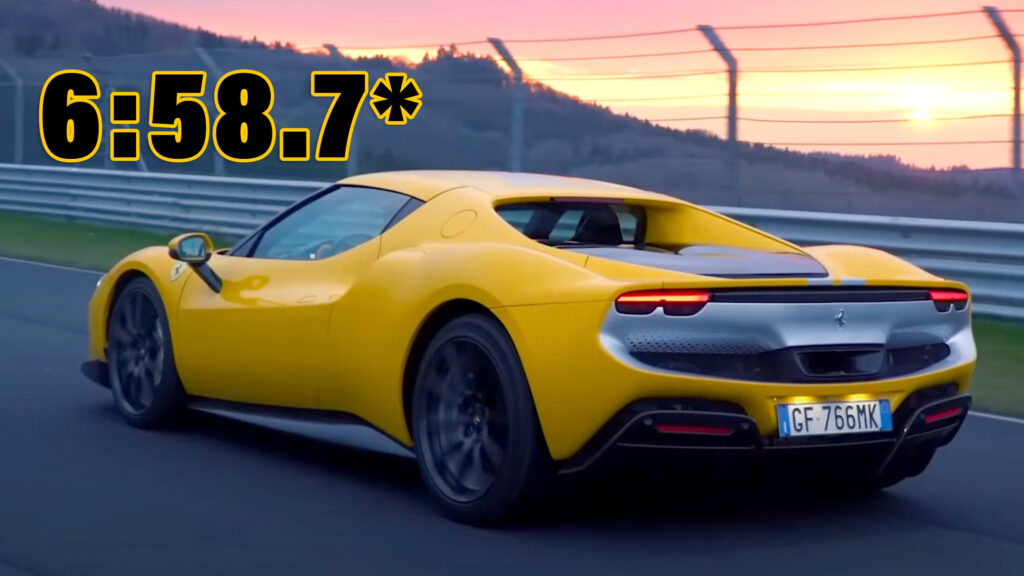Hybrid Ferrari was equipped with track-ready Assetto Fiorano package of Multimatic dampers, lightweight parts and Michelin Pilot Sport Cup 2 R tires
5 hours ago
 –>
–> 
–>
Going sub-seven at the ’Ring is like breaking into the nines in the 100 m sprint. Only the very fastest make the grade, and we can add the Ferrari 296 GTB to that rarified list. The baby of Ferrari’s supercar lineup just lapped the Nordschleife in 6:58.7, becoming the first production Ferrari road car to complete the course in less than seven minutes.
Or did it? The Ferrari’s 6:58.7 lap time comes with an asterisk because it was recorded by Sport Auto magazine during an industry pool testing session where it’s not quite possible to run a complete lap flat out. Sport Auto’s time was recorded over 12.8 miles (20.6 km) which was the standard measurement for years and has long been a staple of Sport Auto‘s Super Tests, rather than over 12.9 miles (20.8 km) which is the configuration used for all the recent official automaker records. If you watch the video you can see that the stopwatch starts and stops at slightly different points.
Though the difference is small, and still not picked up by many writers and fans when comparing times, it’s still worth a few seconds, meaning that if we’re being picky, the 296 didn’t really break into the sixes at all. It did according to the criteria of Sport Auto, which has every right to celebrate an incredible achievement, but that time wouldn’t rank as a sub-7-minute one according to the latest understanding of what constitutes a ‘Ring lap.
Related: Nürburgring Lap Times: These Are The Fastest Cars In 2023
[embedded content]
Ferrari doesn’t publish Nurburgring times, so it’s down to the likes of Sport Auto to test them independently when it’s able to get its hands on a car. The fastest Ferrari the magazine had previously tested was the 488 Pista, which recorded 7:00.03 over the 12.8-mile configuration in 2019 with the same driver, super-speedy Christian Gebhardt, at the wheel. And that is of course one reason why Sport Auto continues to record times on the short course: it has years worth of data recorded in the same way for comparison.
Gebhardt opted to test the 296 in its most Nurburgring-friendly specification, which meant the bright yellow car was equipped with the hardcore Assetto Fiorano package comprising of lightweight door panels and rear window, Multimatic dampers and optional Michelin Pilot Sport Cup 2 R tires. Ticking the Assetto box doesn’t add any more power, but with a total of 819 hp (830 PS) and 546 lb-ft (740 Nm) available to the rear wheels from its hybrid-assisted 3.0-liter V6, the 296 isn’t exactly crying out for more poke. Zero to 62 mph (100 km/h) takes 2.9 seconds and Ferrari quotes a top speed of 205 mph (330 km/h), which Gebhardt comes tantalizingly close to hitting on the long straight before the finish line.
advertisement scroll to continue
A 6:58.7 lap is a rapid one, however you slice it (even if it’s 3.5 seconds slower than a 503 hp / 510 PS Porsche 911 GT3 that costs half as much) and you have to give full credit to Gebhardt for going balls to the wall in a regular road-spec press car with no roll cage. But the confusion over the smallprint of that lap time reminds us that the car industry is full of similar, but not directly comparable numbers that have the potential to trip us up when making comparisons.
Others include zero to 60 mph (96 km/h) times that might, or might not, include a drag strip-style rollout, zero to 60 mph times that are actually zero to 62 mph (100 km/h) times, battery figures that might be quoted in gross or net, usable, kWh, and power figures that could be 500 hp, but could just as easily be 500 PS. It’s a numerical minefield out there.
 <!–
<!– –>
–> 